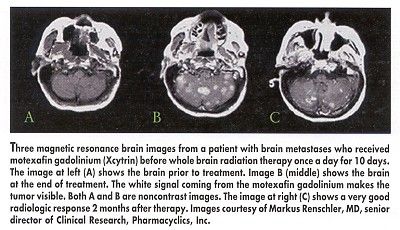Xcytrin Plus Radiation Therapy Targets Brain Metastases
BOSTON-Combining standard radiation with a new drug called motexafin gadolinium (Xcytrin) produced substantial benefits for cancer patients with brain metastases in the lead-in phase of an ongoing phase III clinical trial, according to a report presented at the American Society for Therapeutic Radiology and Oncology (ASTRO) annual meeting.
BOSTONCombining standard radiation with a new drug called motexafin gadolinium (Xcytrin) produced substantial benefits for cancer patients with brain metastases in the lead-in phase of an ongoing phase III clinical trial, according to a report presented at the American Society for Therapeutic Radiology and Oncology (ASTRO) annual meeting.
Tumor volume was reduced by at least 65% in 68% of the 19 patients who could be evaluated by magnetic resonance imaging (MRI); 77% percent of all the patients were free of neurologic progression. Median survival was 5 months, and side effects were minimal, said trial co-chair Minesh P. Mehta, MD, interim chair of the Department of Human Oncology, University of Wisconsin Medical School, Madison.
While the cohort was smallonly 25 of the 425 patients who will be in the complete trialthe results mirrored preliminary studies that also showed reduced tumor volume in close to 70% of patients with brain metastases.
Dr. Mehta told ONI, "It’s good to see that it’s a reproducible number. The number in phase II was not a statistical quirk."

Motexafin gadolinium comes from a family of ring-shaped molecules, called texaphyrins, that Pharmacyclics, Inc., of Sunnyvale, California, is developing as anticancer drugs. These texaphyrins are adapted from porphyrins, a common class of molecule that includes chlorophyll and hemoglobin. Scientists insert gadolinium into the enlarged center of the motexafin molecule, making the agent visible on MRI.
Agent Enters Cancer Cells
When injected into a patient, motex-afin gadolinium enters cancer cells but not normal cells. Dr. Mehta said the scientists don’t know why, but have two possible answers. The first is that proliferating cells, such as cancer cells, turn over porphyrins very rapidly. The second is that cancer cells express receptors that bind to porphyrins.
An additional theory, he said, is that after entering a cancer cell, motexafin gadolinium induces futile redox cycling, depriving it of glucose and triggering cell death. Whether or not that is the case, Dr. Mehta said, "the tumor cells are substantially compromised in their ability to repair radiation-induced damage."
For the lead-in study, 25 patients received an injection of motexafin gadolinium followed by standard whole brain radiation therapy once a day for 10 days. They had an average of 12 brain metastases that had not previously been resected or irradiated from lung (52%), breast (24%), and other cancers.
By Radiation Therapy Oncology Group (RTOG) criteria, 76% of patients were not eligible for radiosurgery.
The drug was well tolerated, with only minor, reversible side effects, such as temporary changes in skin and urine color, nausea, hypertension, and liver enzyme abnormalities in some patients. Nineteen of the patients were able to have at least one follow-up MRI. All were tested for neurocognitive function.
Among the outcomes was an 81% median reduction in tumor volume. Neurocognitive function showed significant improvement for 45% of the patients. Systemic cancer progression or cancer complications were the leading cause of death (71%), followed by central nervous system progression (19%).
The greater the neurocognitive impairment at the outset, the poorer the prospects for survival. Improved survival correlated with improved neurocognitive functioning 1 month after treatment. Only 23% of those who died had neurologic progression.
Quality-of-life gains are especially important in these patients because neurologic problems from brain tumors can be devastating, Dr. Mehta said. Improving the remaining months of their lives is worthwhile, he proposed, even though chances for long-term survival remain poor. "It is not for us to determine whether 1, 2, or 3 months is a valid extension of life," he said. "For many patients, it is worthwhile."
There is hope, he added, that halting brain metastases will allow more time for treatment of primary tumors, especially as new drugs such as trastuzumab (Herceptin) become available.
Other clinical trials underway or being planned will address whether motexafin gadolinium can improve survival rates for patients with primary malignant tumors of the brain, prostate, pancreas, and other disease sites.
Dr. Mehta said he hopes to have results next year from the current multicenter trial, which had enrolled 350 patients as of November 1.
Newsletter
Stay up to date on recent advances in the multidisciplinary approach to cancer.
Elevating the Quality of Cancer Care via Cross-Department Collaboration
Experts from Sibley Memorial Hospital discuss how multidisciplinary work has enhanced outcomes such as survival and resource use at their institution.